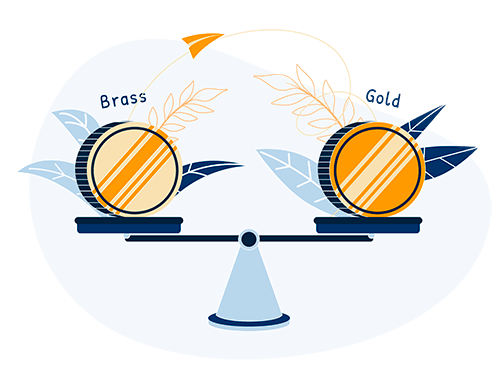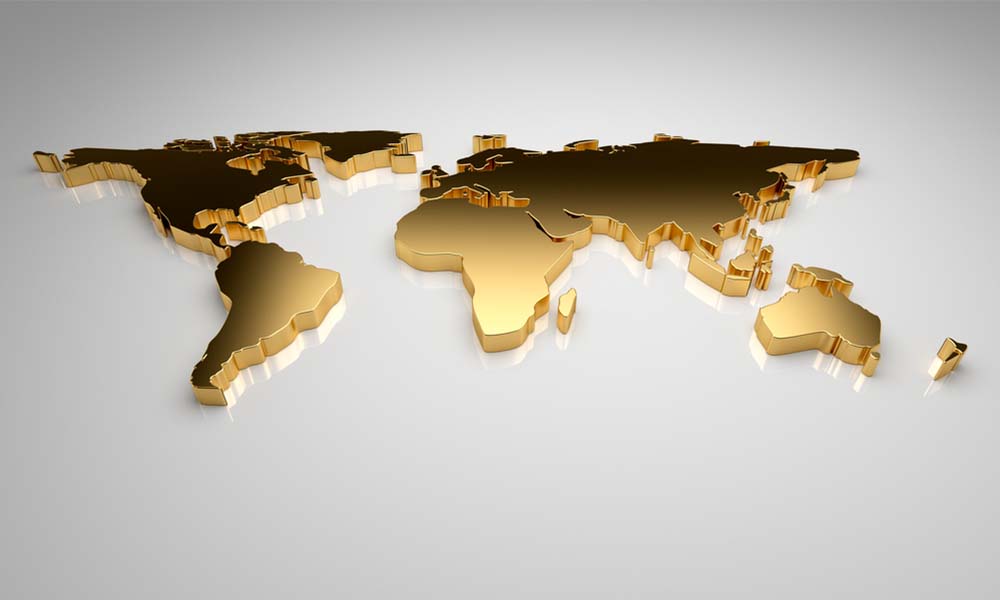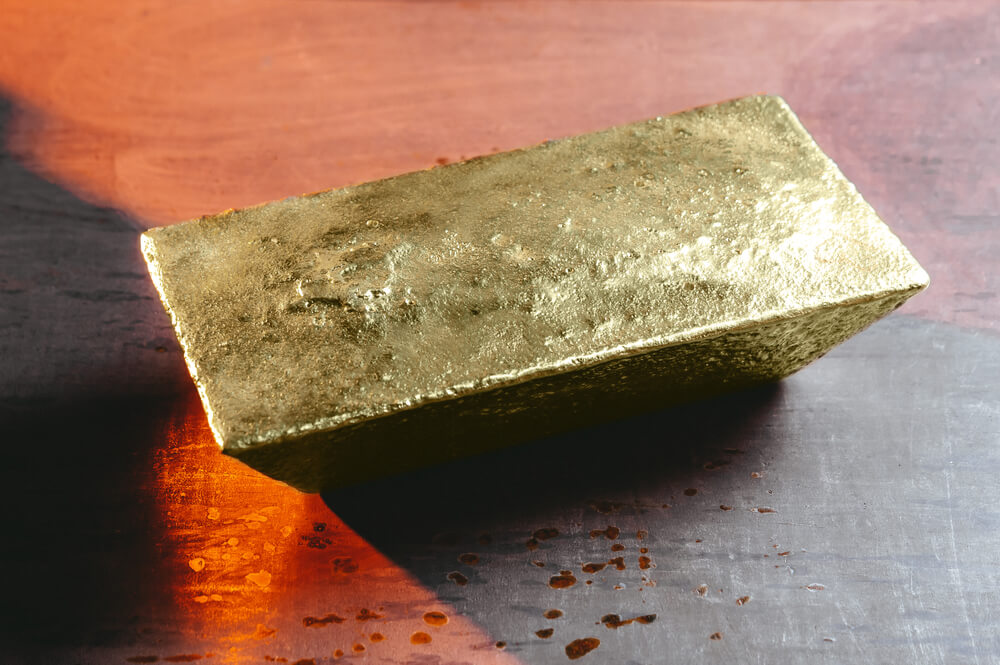
How Much Gold is in the World?
Gold is a natural resource and is in limited supply. You cannot make it, like you cannot concoct other metals. The precious metal helps make or constitutes diverse goods, from jewelry and computer components to spacecraft and communications equipment.
The good news is that gold doesn’t cease to exist upon use, unlike other non-renewable resources — such as coal, natural gas, oil, etc. You can recycle it. The gold in your luxury watch may have been mined several thousand years ago.

Even though gold will be available in some shape or form until (and beyond) the end of life on Earth, gold mines continue to look for new minable gold due to the demand for the metal. Needless to say, gold is among the most sought-after precious metals.
So, exactly how much gold is in the world? How much gold has been mined already? How much gold is left to be mined? Read on to get answers to all those questions and more.
In this in-depth look at gold availability across the globe, you’ll learn:
- The amount of gold discovered and yet to be mined
- The declining mining trends
- What the future beholds, etc.
If you are a keen gold investor, the following pieces of information should be “gold dust” (no pun intended) to you.
Table of Contents
Gold Sources and Production: Some Facts and Numbers
According to the USGS, around 244,000 metric tons (244,000,000 kg) or 537,927,920 pounds of gold have been found to date. How much gold is left? The underground reserve or unmined gold is around 57,000 metric tons.
Most of the gold above ground that contribute to the world’s gold deposits as of 2019 are in the form of (very rough estimates):
- Jewelry: 93,000 tonnes
- Private investment: 43,000 tonnes
- Official holdings: 34,000 tonnes
- Others: 28,000 tonnes
(You might have noticed the numbers do not tally up. Keep reading to learn more why that is the case.)
Every year, mining adds around 2,500 tonnes to the world’s total gold deposits. Up until 1492, 12,780 tonnes of gold had been extracted, as per the Gold Fields Mineral Services (GFMS). Most gold experts and historians, however, find that over-ambitious or hard to believe. (More on that later too)
The majority of the gold discovered is courtesy of China, South Africa, and Australia. Russia, Canada, and Peru are major gold producers as well. In 2016, China contributed the most to the world’s gold production, accounting for close to 14% of the total output. America was the fourth largest contributor during the same year.
China makes around 225 tonnes of gold a year on average, spanning 1990 to 2020. Its peak gold or most gold production in a year was 453.5 tonnes in 2016. In 1990, China’s gold production was the lowest, at around 100 tonnes. In 2020, it had mined 380 tonnes.
As per the World Gold Council, Asia dominates among continents in yearly gold production. Though China is the only Asian country to feature in most top 10 gold-producing country lists, other countries such as South Korea, Indonesia, India, Iran, Japan, Kyrgyzstan, Malaysia, etc., add a great deal to Asia’s annual production total.
The biggest single gold source is South Africa’s Witwatersrand, accounting for around 30% of all gold mined. Other major mining locations include:
- Newmont (USA)
- Barrick Gold (Canada)
- Mponeng Gold Mine (South Africa)
- AngloGold Ashanti (South Africa)
- Newmont Boddington and Super Pit mines (Australia)
- Grasberg mine (Indonesia)
- Polyus (Russia)
- Muruntau gold mine (Uzbekistan)
The extremely deep Mponeng mine is the deepest of all gold mines. The Newton Boddington mine is Australia’s biggest gold mine.
Read more: Gold Options and How to Buy Them
Gold Mining Numbers are “Approximates”
The total amount of gold in the world is still a mystery. The numbers mentioned above are estimates. They are not reported accurately. The figures could vary based on who you ask — thanks to how scattered above-ground gold or numbers pertaining to all the gold is.
The primary reason for this ambiguity is gold mining is several centuries old. According to historians, humans have been mining precious metals for 6,000 years or more. One of the first gold coins to be minted was produced in Lydia (Turkey) around 550 BC.
As mentioned earlier, close to 12,780 tonnes of gold were mined by 1492. But that’s a number most experts disagree with as the ancient mining techniques used back then couldn’t have possibly unearthed that much gold. They would have barely scratched the Earth’s crust. Around 300 tonnes sounds like a more plausible number.
Even today, different gold research companies and analysts come up with non-identical numbers — at times, not even in the same ballpark. And some believe all the mining data or numbers thrown around are conservative or not encompassing all the usable gold on the planet.
Unreported Gold
For example, hundreds (if not thousands) of tombs across the globe are made of gold. One such tomb is Tutankhamun’s tomb, which supposedly has locked in approximately 1.5 tonnes of gold.
And there are societies and even countries that aren’t very open about how much gold they own and what their mining operations are like. Not to mention, illegal mining is a reality in some countries. What transpires out of those activities doesn’t get accounted for.
To ascertain the exact amount of usable gold globally, all the jewelry boxes and bank vaults will have to come out and reveal all. If that were to happen, which is extremely unlikely, the amount of gold humankind has mined and amassed over centuries could touch a few million tonnes.
The Declining Production of Gold
World gold supplies have been slowly decreasing. In 2019, the global gold production was approximately 3,531 tonnes. In 2018, it was 3,567 tonnes. The period 2018-2019 was the first time since 2008 during which gold mine production had declined year on year.
However, the slight falloff doesn’t denote gold production has reached its peak or will continue to drop every year. In other words, the downward trajectory is not significant, but the output has indeed flattened. There’s still some time to reach a point wherein there’s a dramatic decrease.
What Does the Future Hold?
Gold mining is several centuries old. After all these years, gold mining has no doubt reached a certain saturation point.
Mining companies with decades of experience behind them are not outputting gold with the same enthusiasm as they did a few years ago, thanks to how increasingly difficult it’s become to find new gold. Plain exhaustion or the fact that the returns for the efforts put in are plummeting is also a major factor for the insipidness of the firms.
The gold already discovered was much easier to find compared to gold that’s still hiding underneath. A dramatic decrease in production is not very far away.
Though new mining companies are continually cropping up, they haven’t come up with much gold yet. Most of the gold production currently taking place is still courtesy of the older mines. Since mining is a cost- and capital-intensive exercise, the newer, smaller mines do not possess the plant and equipment to tap into underground gold efficiently enough.
The Environment Hazard
Dirty mining practices such as cyanide heap leaching and open-pit mining ravage landscapes, contaminate water supplies and destroy ecosystems. Toxic substances such as mercury and cyanide get released into the atmosphere when gold is not mined responsibly. On the other hand, placer mining is more sustainable due to its small-scale and less invasive nature.
Also, many gold mines in different parts of the world are guilty of dumping toxic wastes into water bodies directly. For instance, the Papua New Guinea-based Lihir gold mine gets continually critiqued for its irresponsible gold mining operations.
Gold mining leads to improved infrastructure, employment opportunities, and tax revenues when performed in adherence to high environmental, safety, and social standards. Sustainable mining can also generate foreign exchanges and drive FDI.
The environmental concerns surrounding the mining of gold are on the rise. Countries are framing and implementing tighter ecological policies for environmental management reasons. Cyanide usage, for instance, is highly regulated in countries like China, forcing many mining firms to cut down on their production.
Gold Recycling is a Challenge
Recycling gold is a lot easier than mining new gold. But the way the yellow metal is getting used and likely to be used in the foreseeable future will majorly impact how efficiently gold could be recycled.
The technology industry employs gold in a manner that renders recycling the precious metal tricky. Because gold is used in small quantities or as specks in electronic gadgets, extracting the metal from obsolete electronic devices is complex or not economically feasible. As a result, a majority of that gold goes to landfills.
The unorganized sectors do manage to pick some gold from the electronic waste. But with no specialized equipment to boot and an unsafe approach, the gold they end up extracting is minuscule compared to what’s there to be recycled.
Long story short, gold is finally getting “consumed” like other natural resources, thanks to the electronics industry and its new technologies.
Read more: Getting Gold From Electronics
Conclusion
Gold is a finite source. It’s estimated by around 2050 (or later), its mining would stop, or the activity would no longer be sustainable. And when that time arrives, the demand and, therefore, the value of gold would be much higher than what it is currently.
If you are considering adding some gold to your investment portfolio, this is likely the right time. The value as instated above is undeniable. But the issue with investing in gold is the various types and purity levels it comes in. Not all forms of gold around are pure gold.
Protect your retirement savings with a Gold IRA
FAQs
Is Earth the only celestial body to possess gold?
Like Earth, other planetary bodies such as the moon and Mars are also believed to hold gold. But it’s not clear how much and whether those known reserves are “minable”.
Mining gold in any place other than Earth would be astronomically expensive. The costs would likely be more than the mined gold’s value. And regardless of how advanced space expeditions get or whether life on Mars becomes a reality, the cost of mining gold in a place other than Earth will remain exorbitantly high.
The current population and even the next few generations may not be alive to see extra-terrestrial gold mining becoming a reality.
Is there any place on Earth where it could be uneconomical to mine gold?
As far as mining regions go, there are quite a few unexplored locations. The 57,000 tonnes of gold remains yet to be touched denote the “known gold deposits”. The unknown underground reserves could be a lot more.
The ones with the greatest potential come under the more unstable terrains, such as West Africa. Antarctica is another place where gold miners have not set shop — thanks to the continent’s extreme weather conditions and remoteness. The extremity of Antarctica renders it cost-inefficient to mine gold there. It’s, therefore, naturally the only place on Earth where gold mining has not been carried out.
Similarly, the world’s oceans are likely to hold gold in hordes, possibly more than the current world’s supply. But tapping into those ocean floor gold reserves would be more challenging and complex than even digging into Antarctica’s landscapes. The option, therefore, is non-feasible too.
What is “producer hedging”?
“Producer hedging” is a term that signifies laying a price tag on gold that is yet to be produced. Miners indulge in such practices to lock in a gold price, which helps them manage debt servicing or project costs. This hedging of gold prices, to a great extent, ascertains the amount of gold that enters the market.
Producer hedging was prominent in the past. In recent times, however, it’s not as rampant, and the arrangements that do get authorized are usually for the short term.


